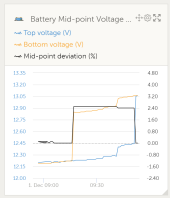I set up my camping system as a semi-permanent fixture in my shed to experiment with this year, and up in Minneapolis temperatures have been less than balmy. I added some heating pads and wrapped my battery box with insulation, but as the days are shorter and the temps colder, I've gotten in the habit of shutting down the loads (including the Venus OS system monitoring things) overnight (using a Victron Battery Protect as a load switch) and then starting it in the morning when (if) it get's sunny.
Batteries are 4 Dakota Lithium 23ah 12v, for a 2p 2s 24v system.
It was colder today (-10C or so outside, battery maybe -4C) and I noticed the battery (at 70% SOC per the smart shunt) was a bit lower voltage than I expected when I started the loads (including the battery heat). I noticed one sharp jump on the bottom pair as they warmed, followed by another sharp voltage increase as the top pair jumped as warming continued. I'm guessing the heating is uneven, or maybe some slight chemisty differences. I'll see if I can post the graph from VRM:


The small jump on both sides is when the heater turned off when the batteries got to 7C or so. The MPPT won't charge below 4C.
Anyway, just curious if this kind of sharp voltage jump is normal with LFP, and if it's chemistry or BMS maybe? I haven't got data on the cooling side, as the computer doing the monitoring (BeagleBone Black with Venus OS) is shut down at night. I tried letting it run but we already had a couple of weeks mostly overcast and even the 8 watt system load drains it down over time.
Batteries are 4 Dakota Lithium 23ah 12v, for a 2p 2s 24v system.
It was colder today (-10C or so outside, battery maybe -4C) and I noticed the battery (at 70% SOC per the smart shunt) was a bit lower voltage than I expected when I started the loads (including the battery heat). I noticed one sharp jump on the bottom pair as they warmed, followed by another sharp voltage increase as the top pair jumped as warming continued. I'm guessing the heating is uneven, or maybe some slight chemisty differences. I'll see if I can post the graph from VRM:


The small jump on both sides is when the heater turned off when the batteries got to 7C or so. The MPPT won't charge below 4C.
Anyway, just curious if this kind of sharp voltage jump is normal with LFP, and if it's chemistry or BMS maybe? I haven't got data on the cooling side, as the computer doing the monitoring (BeagleBone Black with Venus OS) is shut down at night. I tried letting it run but we already had a couple of weeks mostly overcast and even the 8 watt system load drains it down over time.
Last edited:



